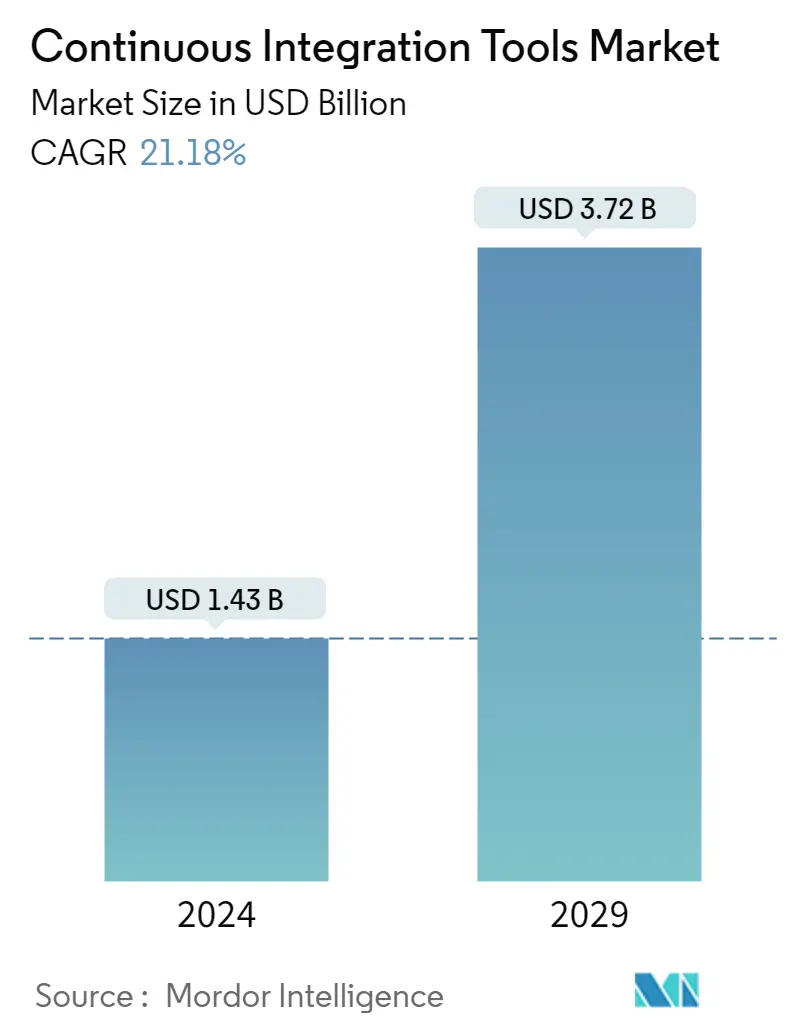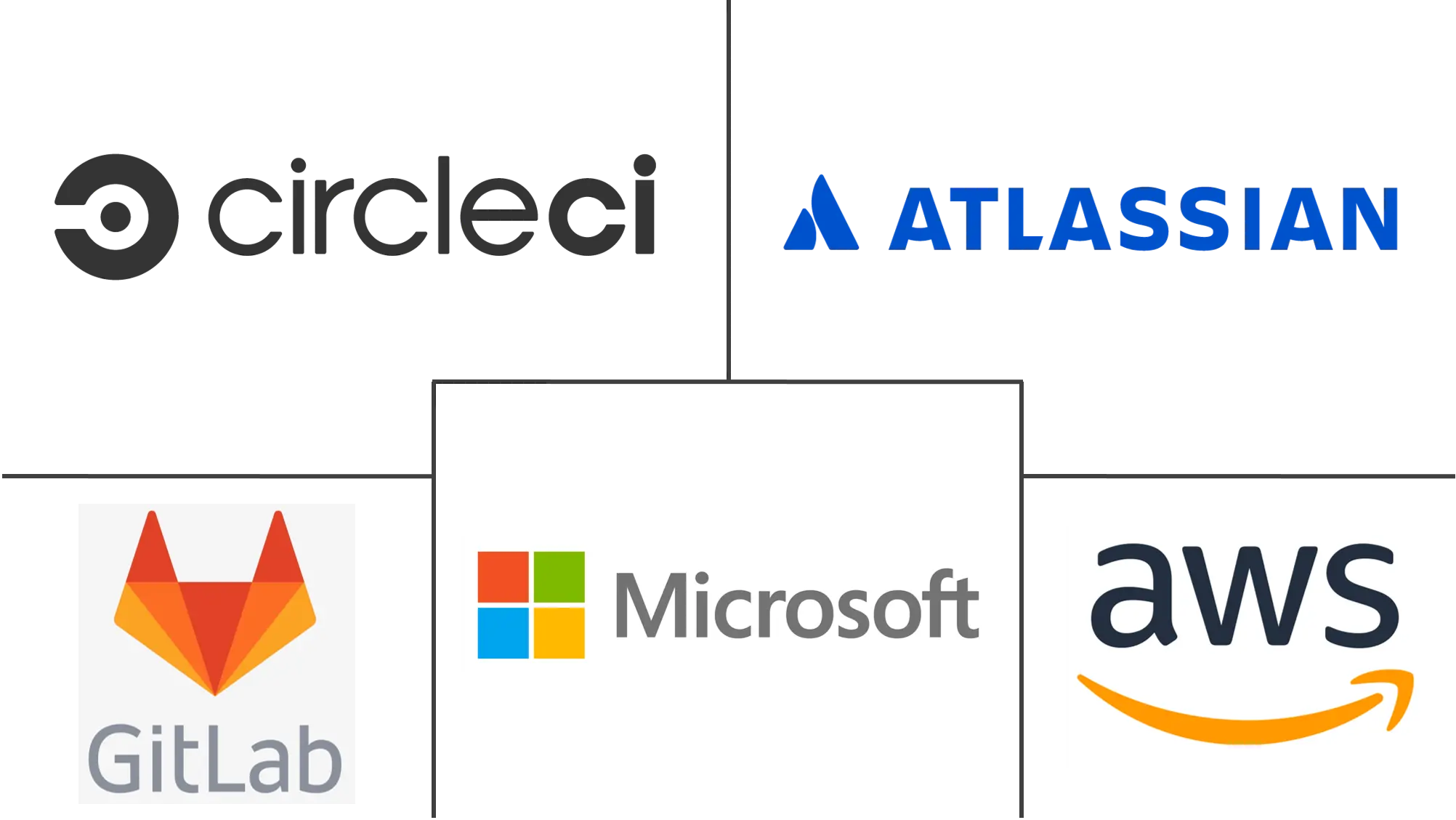Market Size of Continuous Integration Tools Industry

| Study Period | 2021 - 2029 |
| Market Size (2024) | USD 1.43 Billion |
| Market Size (2029) | USD 3.72 Billion |
| CAGR (2024 - 2029) | 21.18 % |
| Fastest Growing Market | Asia Pacific |
| Largest Market | North America |
Major Players
*Disclaimer: Major Players sorted in no particular order |
Continuous Integration Solutions Market Analysis
The Continuous Integration Tools Market size is estimated at USD 1.43 billion in 2024, and is expected to reach USD 3.72 billion by 2029, growing at a CAGR of 21.18% during the forecast period (2024-2029).
Continuous integration is a DevOps method for making software in which developers regularly merge their code changes into a shared repository. After that, automated builds and tests are run on the code.
- Continuous integration (CI) helps developers provide immediate reporting whenever any defect is identified in the code, so immediate corrective action is taken. It is an essential part of DevOps that integrates numerous DevOps stages. The testing phase is also automated and is instantly reported to the user.
- In continuous integration, the software is built and tested immediately after the code commit. In a larger project with many developers, commits are made at various times during the day. With each commit, code is built and tested. If the test case is passed, the build is tested for deployment. If the deployment is a success, the code is pushed to production. This commit, build, test, and deploy is a continuous process, hence the name "continuous integration."
- Various CI tools are available on the market, offering access to unique features. These have open-source and paid versions, and depending on the user's needs, the most preferred can be selected.
- Although all the CI tools are designed to perform the same basic functions, choosing the best CI tool becomes vital in the long run. Multiple tools may also be chosen to meet different needs, depending on things like features, how easy they are to use, and cost, among other things.
- According to a survey by JetBrains (a software company), 43% of software developers will employ continuous integration tools in 2021. Because CI tools are useful, the market is expected to grow positively over the next few years.
Due to the COVID-19 pandemic, several businesses had employees working from home, and the need to adopt CI tools for developers increased substantially. Companies increasingly moved their apps to the cloud or cloud-based platforms. Such incidents necessitated the use of CI tools in a timely manner.
Continuous Integration Solutions Industry Segmentation
Continuous Integration Tools (CI Tools) are an essential component of DevOps and are used to integrate various DevOps stages. It includes an automated testing process, which enables multiple developers to contribute to and collaborate on a shared codebase at a rapid pace. Continuous Integration (CI) tools further help the development team make changes to version control, where software developers share and merge their changes at the time of completion of every project task.
The Continuous Integration Tools Market is segmented by Deployment Mode (On-Premise, On-Cloud), End-User Industry (IT & Telecom, Retail & Ecommerce, Healthcare & Lifesciences, BFSI, Media & Entertainment, Others), and Geography (North America, Europe, Asia Pacific, Latin America, and the Middle East & Africa).
The market sizes and forecasts are provided in terms of value (USD million) for all the above segments.
| Deployment | |
| On-premise | |
| Cloud |
| End-User Industry | |
| IT and Telecom | |
| Retail and E-commerce | |
| Healthcare and Life Sciences | |
| BFSI | |
| Media and Entertainment | |
| Other End-User Industries (Education, Manufacturing) |
| Geography | |
| North America | |
| Europe | |
| Asia Pacific | |
| Latin America | |
| Middle East and Africa |
Continuous Integration Tools Market Size Summary
The Continuous Integration Tools Market is poised for significant growth, driven by the increasing adoption of DevOps practices and the need for efficient software development processes. Continuous integration (CI) is a crucial DevOps methodology that enables developers to merge code changes into a shared repository frequently, followed by automated builds and tests. This approach facilitates immediate defect reporting and corrective actions, enhancing code quality and deployment speed. The market is characterized by a variety of CI tools, both open-source and paid, allowing users to select tools based on their specific needs, such as features, usability, and cost. The demand for CI tools has been further accelerated by the shift towards digital transformation, particularly in the retail and e-commerce sectors, where seamless integration of digital channels and e-commerce operations has become essential.
The North American region stands out as a developed market, with numerous startups and established companies enhancing CI capabilities across various sectors, including BFSI and government initiatives. The adoption of CI infrastructure is gaining momentum, supported by automation tools and integrated security testing, which are crucial for advancing DevOps practices. Partnerships and collaborations, such as those between CircleCI and AWS GovCloud, are fostering innovation and expanding market reach. The competitive landscape is becoming increasingly fragmented, with new entrants and existing players vying for market share. Notable developments include Arista Networks' network automation solution and Amazon's CodeCatalyst, which streamline software development and deployment processes. These advancements underscore the growing importance of CI tools in meeting the demands of modern software development and digital transformation.
Continuous Integration Tools Market Size - Table of Contents
-
1. MARKET INSIGHTS
-
1.1 Market Overview
-
1.2 Industry Attractiveness - Porter's Five Forces Analysis
-
1.2.1 Bargaining Power of Suppliers
-
1.2.2 Bargaining Power of Consumers
-
1.2.3 Threat of New Entrants
-
1.2.4 Threat of Substitutes
-
1.2.5 Intensity of Competitive Rivalry
-
-
1.3 Assessment of the Impact of COVID-19 on the Market
-
-
2. MARKET SEGMENTATION
-
2.1 Deployment
-
2.1.1 On-premise
-
2.1.2 Cloud
-
-
2.2 End-User Industry
-
2.2.1 IT and Telecom
-
2.2.2 Retail and E-commerce
-
2.2.3 Healthcare and Life Sciences
-
2.2.4 BFSI
-
2.2.5 Media and Entertainment
-
2.2.6 Other End-User Industries (Education, Manufacturing)
-
-
2.3 Geography
-
2.3.1 North America
-
2.3.2 Europe
-
2.3.3 Asia Pacific
-
2.3.4 Latin America
-
2.3.5 Middle East and Africa
-
-
Continuous Integration Tools Market Size FAQs
How big is the Continuous Integration Tools Market?
The Continuous Integration Tools Market size is expected to reach USD 1.43 billion in 2024 and grow at a CAGR of 21.18% to reach USD 3.72 billion by 2029.
What is the current Continuous Integration Tools Market size?
In 2024, the Continuous Integration Tools Market size is expected to reach USD 1.43 billion.

